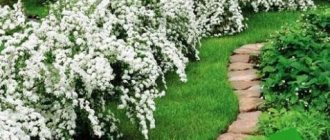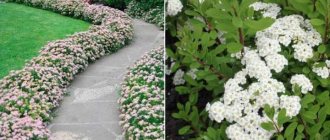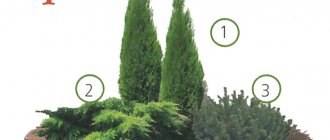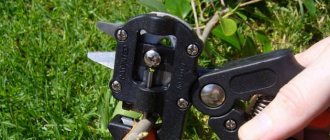How to grow?
How to grow a hedge from boxwood? This plant is unpretentious and can grow in almost any conditions.
The only condition for its successful cultivation is compliance with planting rules. must be met (we talked about the peculiarities of growing boxwood and the rules for caring for it in this article).
Drop off time
Seedlings can be planted from March to November. But the ideal time is to plant in June-July.
Of course, in these hot and most often dry months, abundant watering is required , but the shrub will take root well. This will allow young plants to safely endure winter frosts (read about how to prepare boxwood for wintering here).
Soil composition
Boxwood loves acidic soil .
If the acidity in your area is not sufficient, you can increase it by adding peat. In addition, the bushes will grow well if there is a sufficient amount of magnesium . Its content can be regulated by timely application of mineral fertilizers.
If the soil on the site is dominated by sand, increase its nutritional value by adding humus and chernozem.
To start rooting, you need to add fertilizer to the soil; it is preferable to use compounds with a high nitrogen content.
Landing technique
Seedlings with a good root system are placed in holes or trenches.
Do not bury the plant too deeply; only regrown roots should be in the ground.
After sprinkling the roots, compact the soil around and make a depression. It will subsequently retain water during irrigation.
Watering
For rooting, boxwood needs a sufficient amount of moisture. Therefore, you need to water it regularly and abundantly .
Conservation of soil moisture
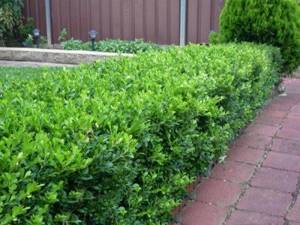
It is not advisable to use pine needles or oak sawdust for mulching.
You cannot make a layer that is too thick, as the roots will begin to grow and go deeper into the ground, and this will put them at risk of drying out.
Do not sprinkle the root collar of the plant so as not to block air access to the roots.
Boxwood hedge ↑
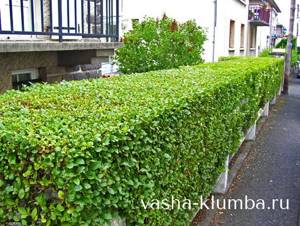
The shrub is also ideal for hedges. 'Handsworthiensis', 'Bullata' and 'Rotundifolia' are best suited for this . These are strong and tall growing varieties. They make a dense, impenetrable fence from the very bottom. It protects well from noise, wind and prying eyes. With sufficient good care, you can form it into a fence up to 3 m in height.
For hedges, boxwood is planted either in one row or in two rows in a checkerboard pattern at a distance of 30 cm.
Planting patterns to create different shapes
In order for the shrub to form the appearance of a hedge, when planting, a cord stretched along a line and secured with pegs is used. An interesting technique is to apply spray paint to the turf along the cord line. A trench dug along this line will be perfectly level, and the boxwood hedge will be the same.
The trench is prepared by removing the turf. The trench width is approximately 60 cm. The depth depends on the root system of the purchased bushes. The roots should sink into the soil to their full height.
Usually the bushes are arranged in one row. But if you need to create a dense and wide hedge, you can make two rows, or plant the plants in a checkerboard pattern.
The distance between specimens is 35-45 centimeters.
If you want to create a border in the form of a circle for planting inside flower arrangements, outline the circle using the means at hand. Stick a peg into the center of the future circle with a cord or rope tied to it, a length equal to the radius of the future circle.
Tie a can of spray paint to the other end. Draw a circle by pulling the rope evenly and going around the peg. You will get a perfect circle and, by planting boxwood bushes around it, you will get a round flowerbed.
Plants for hedges. Boxwood.
Boxwood (Buxus) is an evergreen tree or shrub with strong, heavy wood.
Boxwood is valued for its beautiful dense crown with small dense leathery leaves; the inconspicuous flowers have a strong aroma of honey. The genus has about fifty species, most of which are heat-loving and grown in countries with mild winters. Of all the types of boxwood, one species is most widespread: evergreen boxwood (B. sempervirens), which is one of the fairly frost-resistant species and therefore can be grown in Russia. There are many forms of boxwood evergreen; Varieties with more or less large leaves, including those with golden and variegated leaves, have been bred.
Dwarf varieties of evergreen boxwood in the form of small fluffy bushes with a strongly branching crown and short annual growths successfully winter in northern latitudes with dry shelter for the winter (spruce branches, a frame of boxes).
If the boxwood loses its compactness or freezes, it is trimmed. Boxwood tolerates cutting and shaping very well, so it is often used to create trimmed forms and borders, “patterned” parterres (resembling a carpet in design). Boxwood is shade-tolerant and can easily withstand transplantation at any age. For successful growth, it needs dry, well-drained soils with an alkaline reaction. Boxwood overwinters worse on clay soils than on loose soils. Boxwood is a good neighbor, low shrubs that provide light shading, and creeping conifers.
Gardeners often grow boxwood into a dense, evergreen hedge, and it can also be grown as a container plant.
Boxwood has small, shiny, numerous leaves that densely cover the branches of the bush; it tolerates regular trimming, shaping and heavy pruning very well - it is a classic plant for creating borders, topiaries and hedges of varying heights.
Commonly grown as a hedge, the common boxwood or evergreen boxwood (B. sempervirens) is native to the Mediterranean countries, where it grows as a beautiful tree up to 10 meters high, living up to 800 years. Bolearic boxwood is a much taller tree (up to 20 meters in height) with a dense crown and larger leaves, often growing as a bush.
Common boxwood is more common in culture than other species; there are many forms of it. When grown in the garden as a bush, it reaches a height of about 3-5 meters without cutting. Compact varieties of evergreen boxwood have also been bred for creating borders and low hedges, and dwarf varieties for edging paths and dividing flower beds.
Boxwood undergoes regular trimming from May to August every six weeks to ensure that hedges or clipped figures from it have a perfect, neat and compact appearance.
The boxwood crown is formed in the summer, pruning it in accordance with the plan and at the same time removing unnecessary branches. Green cuttings about 10 cm long cut from boxwood bushes can be used for vegetative propagation - this will allow you to obtain many plants for planting hedges.
Boxwood cuttings are rooted in the summer in a special cold greenhouse or planted in a fairly shaded place in the garden, watering regularly. Boxwood takes a long time to take root (this can take a whole year).
Boxwood can easily withstand transplantation at any age. Usually it is planted for a hedge in one row, but if you want to create a fairly wide and dense hedge in the form of a thick wall as quickly as possible, planting in two rows, in a checkerboard pattern, is also practiced. After planning the location of the hedge in the garden and determining the planting line, a cord is pulled along it and plants are planted (usually at a distance of 35-45 cm, and dwarf boxwood varieties are even closer). Find out about the recommended distance between neighboring plants in a hedge (depending on the width of an adult bush of a given variety) at the nursery when purchasing boxwood.
How to form ideal hedges?
Timely formative pruning 
When to trim boxwood? Young bushes need pruning several times during the season - in spring, mid-summer, early autumn (you can find out about the rules for caring for boxwood in the fall here). From the second year, the procedure is carried out once a year.
Pruning is carried out using garden shears or pruning shears . There are also special professional scissors for trimming bushes. Make sure that the blades of the pruning tools are sharp, otherwise the trimmed ends will become shaggy and lose their beauty.
Prune bushes only in the evening to avoid bright sun from burning the leaves.
After pruning, water the bushes generously with water and fertilizer, as the procedure is stressful for the plant. And this will help him recover quickly.
Cutting off overgrown shoots directly above the branches will help maintain the desired height.
Pruning side shoots promotes the formation of dense, dense bushes.
To give the borders the correct geometric shape, you can use a metal mesh placed over the bushes. All shoots protruding through it must be pruned.
It is also necessary to remove all dried and damaged branches, they give the bushes an unkempt appearance.
Boxwood shoots and foliage are toxic , so it is recommended to work with gloves and sleeves.
Boxwood and its features
Boxwood is a slow-growing plant with dense, shiny foliage whose shoots can be shaped by pruning, even turning shrubs into works of art. The shoots on the bush are protruding, have a tetrahedral shape, and the leaves are thick and attractive. Boxwood flowers and produces fruits that produce seeds. The seeds are black and resemble apple seeds. They have excellent germination, but form in late autumn and this is what limits the propagation of boxwood by seeds.
Some types of boxwood, which are used to form borders and hedges, grow for 500 years and reach a height of up to 2 ÷ 5 m. But most often, dwarf boxwood is used, with the help of which small-height hedges and borders are formed.
The plant itself is unpretentious to the type of soil, is not afraid of shade, sun and grows well in shaded areas.
Photos
Boxwood is a shrub that seems to be specially created for growing as a hedge. Plant it on your site, and in a couple of years you will get a charming green fence that will decorate the entire garden.
If you find an error, please select a piece of text and press Ctrl+Enter.
Photo of boxwood
Read here Do-it-yourself front garden: beautiful design options and original ideas for decorating your site and garden (125 photos and videos)
Did you like the article?
1+
Reproduction
In gardening, boxwood is propagated exclusively by cuttings, which are planted directly on the garden bed. The best time for planting is spring. You can also achieve good results in the fall, provided that boxwood trees are planted a month before the onset of cold weather. This is necessary in order to give the plants a chance to take root and prepare for winter.
The cuttings are planted in loose, humus-rich soil. On average, about 80% of plants take root successfully, but at first it is better to cover the trees with cans or film. With regular watering, rooting occurs in 25-30 days.
Advice!
To grow tall trees in a very short period, choose cuttings with a length of 20 cm or more
.

